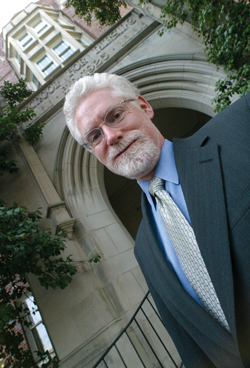
Peter Buerhaus, Ph.D., is examining how nurses perceive the nation’s nursing shortage is impacting patient care, safety, job satisfaction and other
factors.
photo by Neil Brake
Series set to examine impact, perceptions of nursing shortage
The shortage of registered nurses in the United States, which began in 1998, has now become the longest nursing shortage in half a century. Peter Buerhaus, Ph.D., R.N., Valere Potter Professor in Nursing and senior associate dean of Research, says though the shortage is finally showing signs it may be easing, it raises several questions concerning how nurses working on the front lines perceive the shortage.
In the first of a six-part series in the March/April issue of Nursing Economic$, a journal for health care leaders, Buerhaus reveals nurses' perception of the shortage and its impact on patient care, safety and job satisfaction, among other things, by comparing data from two national, random surveys: one completed in 2002 at the height of the current shortage and the second survey conducted in 2004.
Buerhaus and Vanderbilt co-authors Linda Norman, D.S.N., R.N., senior associate dean for Academics, and Robert Dittus, Joe and Morris Werthan Professor of Investigative Medicine and Director of the Center for Health Services Research, found that in some areas, perceptions of RNs changed significantly from 2002 to 2004. “For example, the percent of RNs who identified salary and benefits as a main reason for the shortage dropped from 58 percent in 2002 to 41 percent in 2004, and fewer RNs in 2004 than in 2002 perceived undesirable work hours and a negative work environment as main reasons for the nursing shortage,” stated Buerhaus.
Also collaborating with Buerhaus on the research paper are Beth Ulrich, Ed.D., R.N., senior vice president of Professional Services, Nursing Spectrum/NurseWeek, and Karen Donelan, ScD, senior scientist in Health Policy at Massachusetts General Hospital.
Buerhaus said most RNs continue to see the shortage as a major problem affecting nursing practice. In the 2004 survey, RNs reported the shortage has had a negative impact on early detection of patient complications, maintaining patient safety, and time for team collaboration.
They also reported the shortage has created a major problem for the quality of their work life and the amount of time spent with patients. RNs surveyed said the shortage has also affected hospital processes, by delaying answers to pages or calls, increasing staff communication problems, reducing the number of available hospital beds, increasing patient wait times for surgeries or tests and delaying discharges from the hospital.
In the 2004 survey, RNs were also asked about recruitment and retention efforts at their hospitals. Providing tuition benefits was the recruitment effort seen most frequently and was perceived by those surveyed to be effective.
Offering signing bonuses, flexible scheduling options and increased salaries were also observed as effective by RNs in the survey, but they were not reported to be observed by as many nurses.
“Only one retention initiative was observed by more than half of RNs — mentoring programs for recent new graduates, a strategy that was also perceived as effective by three-quarters of nurses,” said Buerhaus.
The survey comparisons also showed hospitals relied less on overtime in 2004 than in 2002. The percent of RNs who perceived overtime had increased dropped noticeably and RNs reported the amount of “voluntary but feels like mandatory” overtime as well as “required” overtime had decreased.
So, what do RNs think will help most in solving the answer to the shortage crisis? Buerhaus said the surveys are consistent from 2002-2004, showing the majority of nurses think continuing to improve the work environment, increasing salaries and benefits, and raising the status of nurses in hospitals are the best solutions.
“Better hours, financial aid, increased capacity to educate more RNs and using support staff also received support from roughly one-third of RNs in both surveys,” added Buerhaus.
But nurses also think hospitals shouldn't bear sole responsibility for solving the looming problem.
Eight in 10 RNs either strongly or somewhat agree that the federal government and nursing professions are also responsible for solving the nursing shortage.
“The 2004 national survey of RNs makes clear the urgency with which hospitals and nurses need to work together to improve the state of hospital nursing,” said Buerhaus. “Although hospitals, nurses, physicians, nursing educators and policy makers can take some measure of satisfaction that the current nursing shortage has eased and there have been some improvements in the workplace environment over the past few years, nevertheless, this study indicates that much work remains to be done if we are to build a solid and well-prepared workforce for the future.”
Buerhaus' second installment in the six-part series in Nursing Economic$ will focus on RNs perceptions of the nursing profession itself, whether they are satisfied being a nurse, and whether they would recommend nursing to someone else.
The study is part of a larger project evaluating the Johnson & Johnson Campaign for Nursing's Future, a $30 million national initiative aimed at increasing the number of people becoming nurses, retaining nurses in clinical practice and increasing the capacity of the nation's nursing education system.













